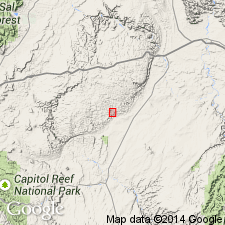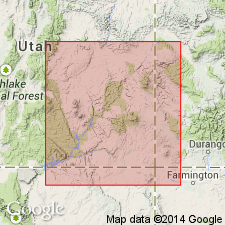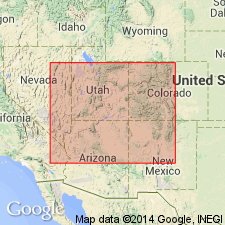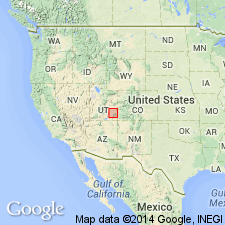
- Usage in publication:
-
- Temple Mountain member*
- Modifications:
-
- Named
- Dominant lithology:
-
- Siltstone
- Mudstone
- Sandstone
- AAPG geologic province:
-
- Paradox basin
Summary:
Named as the basal member of and one of seven members of the Chinle formation for exposures in the Temple Mountain area, southeast flank of San Rafael Swell, Emery Co, UT in the Paradox basin. Type section designated at and described in 38 deg 41' 04" Lat, 110 deg 40' 20" Long, northeast side, South Temple Mountain where the member is 33 ft thick, and unconformably overlies the Moenkopi formation and unconformably underlies the Moss Back member of the Chinle. Composed of 1) conglomeratic sandstone at base characterized by irregular bedding, sorting, and thickness, and in which pebbles range from silt size to 3/4 inch diameter, 2) siltstone that is gray, poorly sorted, has abundant iridescent-purple pebbles of iron oxide, and 3) purple and purple mottled white mudstone that locally has calcareous nodules, interbedded breccia, and jasper lenses. Mottled spots in the mudstone are 1/2 to 4" in diameter. Siltstone and mudstone are in about equal proportions. Coalified logs and plant remains found in all three lithologic types. Composition varies within Swell. Ranges from 0-101 ft thick. Was called the purple and white unit, mottled unit, and pinto bed in earlier reports. Forms a purple ledge or slope. Is a stream laid deposit. No fossils. Late Triassic age. Geologic map.
Source: GNU records (USGS DDS-6; Denver GNULEX).

- Usage in publication:
-
- Temple Mountain member*
- Modifications:
-
- Areal extent
- Overview
- AAPG geologic province:
-
- Paradox basin
Summary:
Author believes that 1) use of the Temple Mountain member of the Chinle formation should be restricted to the San Rafael Swell, Emery Co, UT, Paradox basin, and 2) the Shinarump member of the Chinle formation as revised in this report should be restricted from the Swell. Correlation of Temple Mountain outside the Swell is uncertain. Temple Mountain distinguished from other Chinle units by its distinctive purple and white coloration, presence of medium- to coarse-grained quartz grains in the siltstone, presence of sandstone containing coarse quartz pebbles, and presence of iron oxide pebbles, carbonaceous material, and lenses of jasper. Averages 20 ft thick. Unconformably overlies Moenkopi formation. Underlies Monitor Butte member in southern part of Swell and Moss Back member (new) in northern part of Swell. Temple Butte-Monitor Butte contact is erosional surface. Cross sections. Late Triassic age.
Source: GNU records (USGS DDS-6; Denver GNULEX).

- Usage in publication:
-
- Temple Mountain Member*
- Modifications:
-
- Overview
- AAPG geologic province:
-
- Paradox basin
Summary:
Is the basal member of the Chinle Formation which occurs in 85 percent of the Chinle outcrops in the San Rafael Swell area, Emery Co, UT, Paradox basin. Composed predominantly of mottled strata. Temple Mountain is only one of several units regionally in the basal part of the Chinle that are noted for mottled strata. Measured section 34.1 ft thick on northeast corner on North Temple Mountain, long 110 deg 40 min 35 sec W, lat 38 deg 41 min 20 sec N described [not far from type measured by Robeck, 1956]. Fence diagram. Nomenclature chart. Cross section. Measured sections. Cycadophyte and conifer fossils listed. Late Triassic age. Mottled zone may represent fossil soil.
Source: GNU records (USGS DDS-6; Denver GNULEX).

- Usage in publication:
-
- Temple Mountain Member*
- Modifications:
-
- Overview
- AAPG geologic province:
-
- Paradox basin
Summary:
Lower member of Chinle Formation; recognized only in San Rafael Swell area, southeast UT, Paradox basin. Thickness is generally 20-30 ft, though is up to 100 ft locally in a channel. Generally regarded as oldest deposit of Chinle and as such is considered to be older than Shinarump Member of Chinle. However, regional stratigraphic studies by G. N. Pipiringos (oral comm., 1975) show that Temple Mountain at places overlies, at other places underlies, and at still other places laterally replaces Shinarump. Thus Temple Mountain and Shinarump are considered contemporaneous units, although time of deposition of the two units varied from place to place. Unconformably overlies Moenkopi Formation; underlies either Moss Back Member, or in southern third of San Rafael Swell, mudstone member of Chinle. Stratigraphic chart and cross section. Late Triassic age.
Source: GNU records (USGS DDS-6; Denver GNULEX).
For more information, please contact Nancy Stamm, Geologic Names Committee Secretary.
Asterisk (*) indicates published by U.S. Geological Survey authors.
"No current usage" (†) implies that a name has been abandoned or has fallen into disuse. Former usage and, if known, replacement name given in parentheses ( ).
Slash (/) indicates name conflicts with nomenclatural guidelines (CSN, 1933; ACSN, 1961, 1970; NACSN, 1983, 2005, 2021). May be explained within brackets ([ ]).

